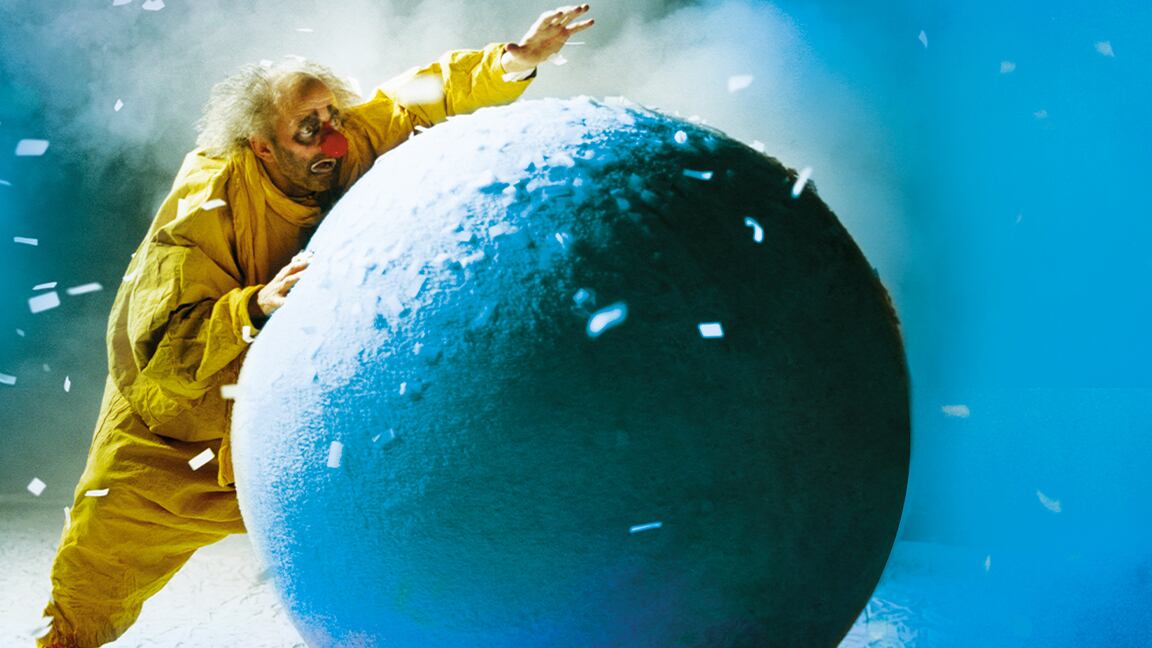The interval is when things go really crazy. It’s not just that the clowns in Slava’s Snowshow start clambering over the audience in the stalls of Broadway’s Stephen Sondheim Theatre (to Jan. 5, 2020), but they start drenching everyone with water spinning in airborne cartwheels from their umbrellas. They sit on laps, can’t work out which way they want to go, drape themselves everywhere, get stuck, and then scraps of paper start being thown. Merry chaos.
So if you’re getting a seat at Slava’s Snowshow go for the front to middle of the stalls, for the full messy glory of it. Oddly, this bananas slapstick isn’t the distinguishing feature of the show, it is the clowning itself. Led by the show’s creator, Slava Polunin, who enters the stage pulling something on a rope, these clowns look and act sad, then menacing, then happy, then sad again. The audience revels in it all, and their mischief.
The traditions of clowning in the show—where sitting at a chair at an angle, then falling off a chair multiple times, can seem puzzling and hilarious—are fascinating. The cast are marvelous. Not much happens, then a lot happens. If you find clowns endlessly enchanting, this is the show for you; if you find clowns unaccountably menacing, these preconceptions won’t be entirely obliterated.
This is an all-kinds-of-clowns show, whose program lists the company members all by name (including Vanya Polunin, Slava’s son) and announces, “it is rarely known in advance which clowns will perform at which performances.” The names of that day’s players are in the lobby.
Polunin’s character, Assissiaï, came first; variously, gentle, naïve, ironic, resolute, and unbending. Then the idea germinated that these characters could become different characters, according to the Slava website.
Slava’s Snowshow, performed since 1993 all around the world, is enchanting, but not of the cutesy variety. The company explains that it is intended to be a show that “releases us ‘from the jail of adulthood’ to the world of our childhoods. The idea is to fuse drama and comedy.
The stage looks, with scenography by Polunin and Viktor Plotnikov, as if it has a background of huge mattresses. Props appear and disappear. When the interval comes, it is marked with a little light with that written upon it.
We are encouraged, collectively, to raise what looks like a huge cobweb over our heads. The light of a crescent moon moves languidly across the stage. Some of the show is elaborate and bombastic, and some is very quiet and whimsical, such as Polunin preparing to leave the stage with a suitcase and then spying a coat hanging on a stand.
By somehow placing his arm through one of the coat’s sleeves he becomes the coat’s lover, about to bid goodbye. At another moment, a little globe appears suspended on string; Polunin plays with it by gently swinging it and bopping it on the nose.
The clowns—sometimes in yellow suits, sometimes in macs with huge, floppy hats—wander on and off stage, sometimes together, sometimes in apparent dispute, sometimes looking to us for something. They do funny walks and leaps, they make their bodies small, then suddenly stretch big. The simplest physical comedy is a delight. The sketches can be elaborate and simple. They can end dramatically, or quietly. Both the children in the audience and many adults audibly loved Slava’s Snowshow.
The clowns’ expressions, their movements, pratfalls, and japes are amazing to watch. The audience responds to their signals for applause, and then the amount of applause. A sweeping brush is used to tip just one scrap of paper on to someone’s head, and then used to polish someone’s bald pate.
You are absolutely unsure what will happen next. You look to your left, right, and up above. On stage, suddenly a figure on trapeze glides, pendulum-like, in front of us scattering glitter. The stage opens slightly, and a huge glowing orb appears, then recedes. You’ll even see a huge snowball. The clowns are variously hard at work, seeking to entertain, charm, and freak us out.
Right at the end, a figure in white appears, thrashing about, and those in the stalls are assailed by another gale of snow/paper blown by a furious wind. And it’s still not over; giant colorful balls appear, which we the audience must keep up in the air. The ending is perfect for this delightful and strange show—a cavalcade of old-fashioned wonders and curiosity, and an engaging tribute to the clown in all his and her guises.







